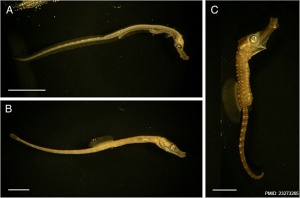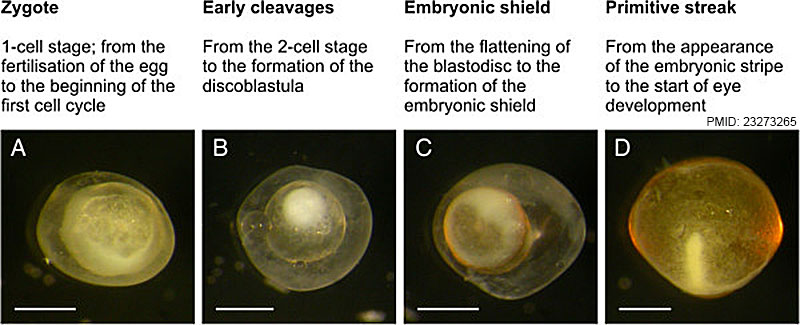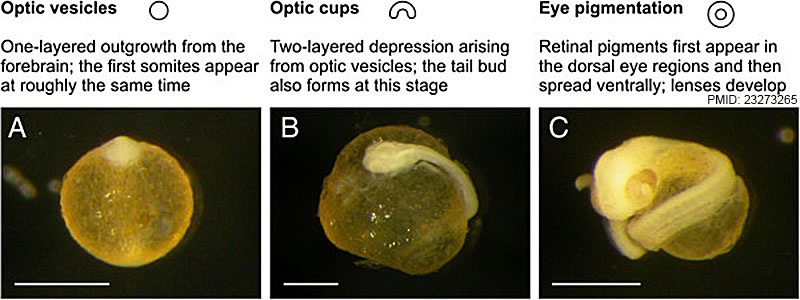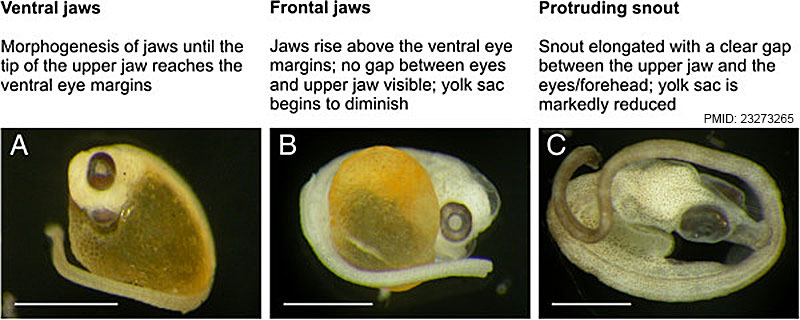Seahorse Development: Difference between revisions
mNo edit summary |
mNo edit summary |
||
| Line 1: | Line 1: | ||
==Introduction== | ==Introduction== | ||
[[File:Syngnathidae development 04.jpg|thumb|Newborns of three syngnathid species (A) N. ophidion, (B) S. abaster, and (C) H. abdominalis. Scale bars are 2 mm.<ref name="PMID23273265"><pubmed>23273265</pubmed>| [http://bmcdevbiol.biomedcentral.com/articles/10.1186/1471-213X-12-39 BMC Dev Biol.]</ref>]] | |||
Hippocampus (Greek, ''ippos'' = horse; ''kampe'' = curvature) | Hippocampus (Greek, ''ippos'' = horse; ''kampe'' = curvature) | ||
| Line 82: | Line 83: | ||
==Developmental Stages== | ==Developmental Stages== | ||
Then following images and staging information is from a study of ''N. ophidion'', ''S. abaster'', and ''H. abdominalis.'' development.<ref><pubmed>23273265</pubmed>| [http://bmcdevbiol.biomedcentral.com/articles/10.1186/1471-213X-12-39 BMC Dev Biol.]</ref> | Then following images and staging information is from a study of ''N. ophidion'', ''S. abaster'', and ''H. abdominalis.'' development.<ref name="PMID23273265"><pubmed>23273265</pubmed>| [http://bmcdevbiol.biomedcentral.com/articles/10.1186/1471-213X-12-39 BMC Dev Biol.]</ref> | ||
[[File:Syngnathidae development 01.jpg|800px]] | [[File:Syngnathidae development 01.jpg|800px]] | ||
Revision as of 18:18, 19 January 2016
Introduction

Hippocampus (Greek, ippos = horse; kampe = curvature)
Actinopterygii (ray-finned fishes) > Syngnathiformes (Pipefishes and seahorses) > Syngnathidae (Pipefishes and seahorses) > Hippocampinae
| Animal Development: axolotl | bat | cat | chicken | cow | dog | dolphin | echidna | fly | frog | goat | grasshopper | guinea pig | hamster | horse | kangaroo | koala | lizard | medaka | mouse | opossum | pig | platypus | rabbit | rat | salamander | sea squirt | sea urchin | sheep | worm | zebrafish | life cycles | development timetable | development models | K12 |
Some Recent Findings
|
Standardised classification of pre-release development in male-brooding pipefish, seahorses, and seadragons (Family Syngnathidae)
BMC Dev Biol. 2012 Dec 29;12:39. doi: 10.1186/1471-213X-12-39.
Sommer S, Whittington CM, Wilson AB. Source Institute of Evolutionary Biology and Environmental Studies, University of Zürich, Winterthurerstrasse 190, Zürich, CH-8057, Switzerland. stefan.sommer@ieu.uzh.ch.
Abstract
BACKGROUND: Members of the family Syngnathidae share a unique reproductive mode termed male pregnancy. Males carry eggs in specialised brooding structures for several weeks and release free-swimming offspring. Here we describe a systematic investigation of pre-release development in syngnathid fishes, reviewing available data for 17 species distributed across the family. This work is complemented by in-depth examinations of the straight-nosed pipefish Nerophis ophidion, the black-striped pipefish Syngnathus abaster, and the potbellied seahorse Hippocampus abdominalis.
RESULTS: We propose a standardised classification of early syngnathid development that extends from the activation of the egg to the release of newborn. The classification consists of four developmental periods - early embryogenesis, eye development, snout formation, and juvenile - which are further divided into 11 stages. Stages are characterised by morphological traits that are easily visible in live and preserved specimens using incident-light microscopy.
CONCLUSIONS: Our classification is derived from examinations of species representing the full range of brooding-structure complexity found in the Syngnathidae, including tail-brooding as well as trunk-brooding species, which represent independent evolutionary lineages. We chose conspicuous common traits as diagnostic features of stages to allow for rapid and consistent staging of embryos and larvae across the entire family. In view of the growing interest in the biology of the Syngnathidae, we believe that the classification proposed here will prove useful for a wide range of studies on the unique reproductive biology of these male-brooding fish.
Common Name - Seahorse
| Country | Species |
|---|---|
| Cuba | Hippocampus erectus |
| Malaysia | Hippocampus erectus |
| Malaysia | Hippocampus histrix |
| Malaysia | Hippocampus kuda |
| Malaysia | Hippocampus spinosissimus |
| Malaysia | Hippocampus barbouri |
| Malaysia | Hippocampus comes |
| Azores Islands | Hippocampus histrix |
| Puerto Rico | Hippocampus reidi |
| St Helena | Hippocampus erectus |
| United Kingdom | Hippocampus guttulatus |
Table data from Fishbase.[2]
Developmental Stages
Then following images and staging information is from a study of N. ophidion, S. abaster, and H. abdominalis. development.[1]
Figure 1 Early embryogenesis Descriptions of the four stages of the early-embryogenesis period, along with examples for each stage. (A) Animal-pole view of a zygote of N. ophidion ca. 45 min after mating. (B) Animal-pole view of a N. ophidion blastula during early cleavages. (C) Embryonic-shield stage in N. ophidion; the white circle represents the germ ring. (D) Primitive-streak embryo of S. abaster (dechorionated). Scale bars are 0.5 mm.
Figure 2 Eye development Descriptions and schematic drawings of stage-defining eye-structures of the three stages of the eye-development period, along with examples for each stage. (A) Optic-vesicle stage in N. ophidion. (B) Optic-cup stage in S. abaster. (C) Eye-pigmentation stage in N. ophidion. All embryos were dechorionated prior to photographing. Scale bars are 0.5 mm.
Figure 3 Snout formation. Descriptions of the three stages of the snout-formation period, along with examples for each stage. (A) S. abaster embryo (dechorionated) with ventrally developing jaws. (B) H. abdominalis larva with jaws rising frontally. (C) S. abaster larva with an elongated snout. Scale bars are 1 mm.
Figure 4 Newborns of three syngnathid species. The newborn stage represents the first stage of the juvenile period and, for the purpose of this classification, refers to the first day post-release. Shown are (A) N. ophidion, (B) S. abaster, and (C) H. abdominalis. Scale bars are 2 mm.
References
- ↑ 1.0 1.1 1.2 <pubmed>23273265</pubmed>| BMC Dev Biol. Cite error: Invalid
<ref>tag; name 'PMID23273265' defined multiple times with different content Cite error: Invalid<ref>tag; name 'PMID23273265' defined multiple times with different content - ↑ Froese, R. and D. Pauly. Editors. 2012. FishBase. World Wide Web electronic publication. www.fishbase.org, version (12/2012).
Reviews
Articles
<pubmed></pubmed> <pubmed></pubmed> <pubmed></pubmed> <pubmed></pubmed> <pubmed>17691105</pubmed> <pubmed>11396574</pubmed>
Search Pubmed
Search Pubmed: Syngnathidae development | seahorse development
10 Most Recent
Note - This sub-heading shows an automated computer PubMed search using the listed sub-heading term. References appear in this list based upon the date of the actual page viewing. Therefore the list of references do not reflect any editorial selection of material based on content or relevance. In comparison, references listed on the content page and discussion page (under the publication year sub-headings) do include editorial selection based upon relevance and availability. (More? Pubmed Most Recent)
Syngnathidae Development
<pubmed limit=5>Syngnathidae Development</pubmed>
Seahorse Development
<pubmed limit=5>Seahorse Development</pubmed>
Pipefish Development
<pubmed limit=5>Pipefish Development</pubmed>
Seadragon Development
<pubmed limit=5>Seadragon Development</pubmed>
External Links
External Links Notice - The dynamic nature of the internet may mean that some of these listed links may no longer function. If the link no longer works search the web with the link text or name. Links to any external commercial sites are provided for information purposes only and should never be considered an endorsement. UNSW Embryology is provided as an educational resource with no clinical information or commercial affiliation.
| Animal Development: axolotl | bat | cat | chicken | cow | dog | dolphin | echidna | fly | frog | goat | grasshopper | guinea pig | hamster | horse | kangaroo | koala | lizard | medaka | mouse | opossum | pig | platypus | rabbit | rat | salamander | sea squirt | sea urchin | sheep | worm | zebrafish | life cycles | development timetable | development models | K12 |
Glossary Links
- Glossary: A | B | C | D | E | F | G | H | I | J | K | L | M | N | O | P | Q | R | S | T | U | V | W | X | Y | Z | Numbers | Symbols | Term Link
Cite this page: Hill, M.A. (2024, April 25) Embryology Seahorse Development. Retrieved from https://embryology.med.unsw.edu.au/embryology/index.php/Seahorse_Development
- © Dr Mark Hill 2024, UNSW Embryology ISBN: 978 0 7334 2609 4 - UNSW CRICOS Provider Code No. 00098G



